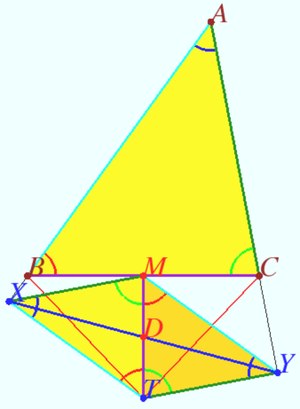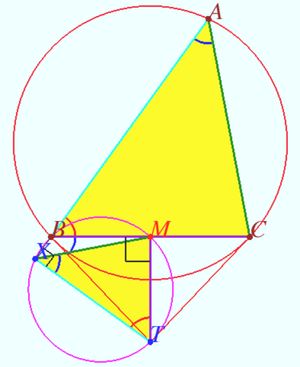Difference between revisions of "2020 AIME II Problems/Problem 15"
(→Solution 4 (Similarity and median)) |
(→Solution 4 (Similarity and median)) |
||
| Line 74: | Line 74: | ||
==Solution 4 (Similarity and median)== | ==Solution 4 (Similarity and median)== | ||
[[File:2020 AIME II 15a.png|300px|right]] | [[File:2020 AIME II 15a.png|300px|right]] | ||
| − | Using the <i><b> | + | Using the <i><b>Claim</b></i> (below) we get <math>\triangle ABC \sim \triangle XTM \sim \triangle YMT.</math> |
Corresponding sides of similar <math>\triangle XTM \sim \triangle YMT</math> is <math>MT,</math> so | Corresponding sides of similar <math>\triangle XTM \sim \triangle YMT</math> is <math>MT,</math> so | ||
| Line 88: | Line 88: | ||
[[File:2020 AIME II 15.png|300px|right]] | [[File:2020 AIME II 15.png|300px|right]] | ||
| − | <i><b> | + | <i><b>Clime</b></i> |
Let <math>\triangle ABC</math> be an acute scalene triangle with circumcircle <math>\omega</math>. The tangents to <math>\omega</math> at <math>B</math> and <math>C</math> intersect at <math>T</math>. Let <math>X</math> be the projections of <math>T</math> onto line <math>AB</math>. Let M be midpoint BC. Then triangle ABC is similar to triangle XTM. | Let <math>\triangle ABC</math> be an acute scalene triangle with circumcircle <math>\omega</math>. The tangents to <math>\omega</math> at <math>B</math> and <math>C</math> intersect at <math>T</math>. Let <math>X</math> be the projections of <math>T</math> onto line <math>AB</math>. Let M be midpoint BC. Then triangle ABC is similar to triangle XTM. | ||
| Line 100: | Line 100: | ||
<math>\angle CBT = \angle BAC = \frac {\overset{\Large\frown} {BC}}{ 2} \implies \triangle ABC \sim \triangle XTM.</math> | <math>\angle CBT = \angle BAC = \frac {\overset{\Large\frown} {BC}}{ 2} \implies \triangle ABC \sim \triangle XTM.</math> | ||
| − | + | '''vladimir.shelomovskii@gmail.com, vvsss''' | |
| − | |||
| − | ''' | ||
==See Also== | ==See Also== | ||
Revision as of 03:39, 31 August 2022
Contents
Problem
Let ![]() be an acute scalene triangle with circumcircle
be an acute scalene triangle with circumcircle ![]() . The tangents to
. The tangents to ![]() at
at ![]() and
and ![]() intersect at
intersect at ![]() . Let
. Let ![]() and
and ![]() be the projections of
be the projections of ![]() onto lines
onto lines ![]() and
and ![]() , respectively. Suppose
, respectively. Suppose ![]() ,
, ![]() , and
, and ![]() . Find
. Find ![]() .
.
Solution
Assume ![]() to be the center of triangle
to be the center of triangle ![]() ,
, ![]() cross
cross ![]() at
at ![]() , link
, link ![]() ,
, ![]() . Let
. Let ![]() be the middle point of
be the middle point of ![]() and
and ![]() be the middle point of
be the middle point of ![]() , so we have
, so we have ![]() . Since
. Since ![]() , we have
, we have ![]() . Notice that
. Notice that ![]() , so
, so ![]() , and this gives us
, and this gives us ![]() . Since
. Since ![]() is perpendicular to
is perpendicular to ![]() ,
, ![]() and
and ![]() cocycle (respectively), so
cocycle (respectively), so ![]() and
and ![]() . So
. So ![]() , so
, so ![]() , which yields
, which yields ![]() So same we have
So same we have ![]() . Apply Ptolemy theorem in
. Apply Ptolemy theorem in ![]() we have
we have ![]() , and use Pythagoras theorem we have
, and use Pythagoras theorem we have ![]() . Same in
. Same in ![]() and triangle
and triangle ![]() we have
we have ![]() and
and ![]() . Solve this for
. Solve this for ![]() and
and ![]() and submit into the equation about
and submit into the equation about ![]() , we can obtain the result
, we can obtain the result ![]() .
.
(Notice that ![]() is a parallelogram, which is an important theorem in Olympiad, and there are some other ways of computation under this observation.)
is a parallelogram, which is an important theorem in Olympiad, and there are some other ways of computation under this observation.)
-Fanyuchen20020715
Solution 2 (Official MAA)
Let ![]() denote the midpoint of
denote the midpoint of ![]() . The critical claim is that
. The critical claim is that ![]() is the orthocenter of
is the orthocenter of ![]() , which has the circle with diameter
, which has the circle with diameter ![]() as its circumcircle. To see this, note that because
as its circumcircle. To see this, note that because ![]() , the quadrilateral
, the quadrilateral ![]() is cyclic, it follows that
is cyclic, it follows that
![]() implying that
implying that ![]() . Similarly,
. Similarly, ![]() . In particular,
. In particular, ![]() is a parallelogram.
is a parallelogram.
![[asy] defaultpen(fontsize(8pt)); unitsize(0.8cm); pair A = (0,0); pair B = (-1.26,-4.43); pair C = (-1.26+3.89, -4.43); pair M = (B+C)/2; pair O = circumcenter(A,B,C); pair T = (0.68, -6.49); pair X = foot(T,A,B); pair Y = foot(T,A,C); path omega = circumcircle(A,B,C); real rad = circumradius(A,B,C); filldraw(A--B--C--cycle, rgb(0/255,0/255,255/255)); label("$\omega$", O + rad*dir(45), SW); filldraw(T--Y--M--X--cycle, rgb(0/255,255/255,0/255)); draw(M--T); draw(X--Y); draw(B--T--C); draw(A--X--Y--cycle); draw(omega); dot("$X$", X, W); dot("$Y$", Y, E); dot("$O$", O, W); dot("$T$", T, S); dot("$A$", A, N); dot("$B$", B, W); dot("$C$", C, E); dot("$M$", M, N); [/asy]](http://latex.artofproblemsolving.com/0/9/9/099a25a57bfde8c253cbc9198405101abfdd6086.png) Hence, by the Parallelogram Law,
Hence, by the Parallelogram Law,
![]() But
But ![]() . Therefore
. Therefore ![]()
Solution 3 (Law of Cosines)
Let ![]() be the orthocenter of
be the orthocenter of ![]() .
.
Lemma 1: ![]() is the midpoint of
is the midpoint of ![]() .
.
Proof: Let ![]() be the midpoint of
be the midpoint of ![]() , and observe that
, and observe that ![]() and
and ![]() are cyclical. Define
are cyclical. Define ![]() and
and ![]() , then note that:
, then note that:
![]() That implies that
That implies that ![]() ,
, ![]() , and
, and ![]() . Thus
. Thus ![]() and
and ![]() ;
; ![]() is indeed the same as
is indeed the same as ![]() , and we have proved lemma 1.
, and we have proved lemma 1.
Since ![]() is cyclical,
is cyclical, ![]() and this implies that
and this implies that ![]() is a paralelogram.
By the Law of Cosines:
is a paralelogram.
By the Law of Cosines:
![]()
![]()
![]()
![]() We add all these equations to get:
We add all these equations to get:
![]() We have that
We have that ![]() and
and ![]() using our midpoints. Note that
using our midpoints. Note that ![]() , so by the Pythagorean Theorem, it follows that
, so by the Pythagorean Theorem, it follows that ![]() . We were also given that
. We were also given that ![]() , which we multiply by
, which we multiply by ![]() to use equation
to use equation ![]() .
. ![]() Since
Since ![]() , we have
, we have
![]()
![]() Therefore,
Therefore, ![]() . ~ MathLuis
. ~ MathLuis
Solution 4 (Similarity and median)
Using the Claim (below) we get ![]()
Corresponding sides of similar ![]() is
is ![]() so
so
![]() – parallelogram.
– parallelogram.
![]() The formula for median
The formula for median ![]() of triangle
of triangle ![]() is
is
![]()
![]()
![]()
Clime
Let ![]() be an acute scalene triangle with circumcircle
be an acute scalene triangle with circumcircle ![]() . The tangents to
. The tangents to ![]() at
at ![]() and
and ![]() intersect at
intersect at ![]() . Let
. Let ![]() be the projections of
be the projections of ![]() onto line
onto line ![]() . Let M be midpoint BC. Then triangle ABC is similar to triangle XTM.
. Let M be midpoint BC. Then triangle ABC is similar to triangle XTM.
Proof
![]() the quadrilateral
the quadrilateral ![]() is cyclic.
is cyclic.
![]()
![]()
vladimir.shelomovskii@gmail.com, vvsss
See Also
| 2020 AIME II (Problems • Answer Key • Resources) | ||
| Preceded by Problem 14 |
Followed by Last Problem | |
| 1 • 2 • 3 • 4 • 5 • 6 • 7 • 8 • 9 • 10 • 11 • 12 • 13 • 14 • 15 | ||
| All AIME Problems and Solutions | ||
The problems on this page are copyrighted by the Mathematical Association of America's American Mathematics Competitions. 











